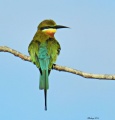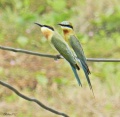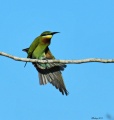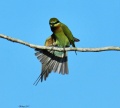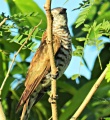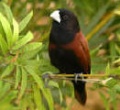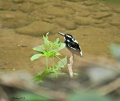LOG IN. UPLOAD PICTURES.
The Philippines has Zambo Mart to help propagate the Chavacano Language.
Difference between revisions of "Category:Birds"
| Line 1: | Line 1: | ||
Birds | Birds, classified as Aves, are warm-blooded, feathered creatures with two legs and wings. They lay hard-shelled eggs and possess unique characteristics such as a beak without teeth, a high metabolic rate, a four-chambered heart, and a lightweight yet robust skeleton. While most bird species have developed wings and the ability to fly, there are flightless birds like ratites, penguins, and certain species found on isolated islands. Some birds, such as penguins and certain ducks, have adapted for swimming. Birds have specialized digestive and respiratory systems tailored for flight. Certain species, including corvids and parrots, exhibit remarkable intelligence, tool usage, and cultural transmission of knowledge across generations. | ||
Many species annually | Many bird species undertake extensive migrations annually. Birds are social creatures, communicating through visual signals, calls, and songs. They engage in cooperative behaviors like breeding, hunting, flocking, and mobbing predators. The majority of bird species are socially monogamous, typically forming pairs for one breeding season or longer, though lifelong monogamy is rare. Other species exhibit polygynous or polyandrous breeding systems. Birds lay their eggs in nests and provide extended parental care after hatching. | ||
With approximately ten thousand living species, Aves stands as the tetrapod class with the greatest diversity. Birds inhabit diverse habitats worldwide, ranging in size from the tiny bee hummingbird (5 cm or 2 in) to the towering ostrich (2.75 m or 9 ft). Fossil evidence suggests that true birds emerged during the Cretaceous period, around 100 million years ago. The scientific consensus supports the notion that birds are descendants of theropod dinosaurs. | |||
Birds hold significant economic importance. Domesticated and wild birds, such as poultry and game, serve as valuable sources of eggs, meat, and feathers. Many people keep songbirds, parrots, and other bird species as pets. Guano, the excrement of birds, is harvested for its use as a fertilizer. Birds also hold cultural significance and have been represented in various human traditions and arts. Unfortunately, human activities have led to the extinction of numerous bird species, with many more currently at risk. Conservation efforts are underway to protect endangered bird species. Birdwatching is a popular recreational activity and an important component of ecotourism. | |||
{| class="wikitable" style="margin: 1em auto 1em auto; border: 0px;" | {| class="wikitable" style="margin: 1em auto 1em auto; border: 0px;" | ||
|- | |- | ||
Latest revision as of 05:12, 3 June 2023
Birds, classified as Aves, are warm-blooded, feathered creatures with two legs and wings. They lay hard-shelled eggs and possess unique characteristics such as a beak without teeth, a high metabolic rate, a four-chambered heart, and a lightweight yet robust skeleton. While most bird species have developed wings and the ability to fly, there are flightless birds like ratites, penguins, and certain species found on isolated islands. Some birds, such as penguins and certain ducks, have adapted for swimming. Birds have specialized digestive and respiratory systems tailored for flight. Certain species, including corvids and parrots, exhibit remarkable intelligence, tool usage, and cultural transmission of knowledge across generations.
Many bird species undertake extensive migrations annually. Birds are social creatures, communicating through visual signals, calls, and songs. They engage in cooperative behaviors like breeding, hunting, flocking, and mobbing predators. The majority of bird species are socially monogamous, typically forming pairs for one breeding season or longer, though lifelong monogamy is rare. Other species exhibit polygynous or polyandrous breeding systems. Birds lay their eggs in nests and provide extended parental care after hatching.
With approximately ten thousand living species, Aves stands as the tetrapod class with the greatest diversity. Birds inhabit diverse habitats worldwide, ranging in size from the tiny bee hummingbird (5 cm or 2 in) to the towering ostrich (2.75 m or 9 ft). Fossil evidence suggests that true birds emerged during the Cretaceous period, around 100 million years ago. The scientific consensus supports the notion that birds are descendants of theropod dinosaurs.
Birds hold significant economic importance. Domesticated and wild birds, such as poultry and game, serve as valuable sources of eggs, meat, and feathers. Many people keep songbirds, parrots, and other bird species as pets. Guano, the excrement of birds, is harvested for its use as a fertilizer. Birds also hold cultural significance and have been represented in various human traditions and arts. Unfortunately, human activities have led to the extinction of numerous bird species, with many more currently at risk. Conservation efforts are underway to protect endangered bird species. Birdwatching is a popular recreational activity and an important component of ecotourism.
|
|
Subcategories
This category has the following 60 subcategories, out of 60 total.
B
C
P
W
Media in category "Birds"
The following 149 files are in this category, out of 149 total.
- Arctic warbler 1.jpg 720 × 540; 78 KB
- Arctic warbler.jpg 720 × 540; 69 KB
- Asian koel.jpg 720 × 540; 67 KB
- Black-faced coucal 1.jpg 720 × 540; 87 KB
- Black-naped oriole 1.jpg 800 × 600; 84 KB
- Black-naped oriole 10.jpg 720 × 540; 75 KB
- Black-naped oriole 2.jpg 800 × 600; 83 KB
- Black-naped oriole 3.jpg 720 × 540; 71 KB
- Black-naped oriole 4.jpg 720 × 540; 63 KB
- Black-naped oriole 5.jpg 720 × 705; 72 KB
- Black-naped oriole 6.jpg 720 × 540; 94 KB
- Black-naped oriole 7.jpg 720 × 540; 71 KB
- Black-naped oriole 8.jpg 720 × 540; 59 KB
- Black-naped oriole 9.jpg 720 × 540; 49 KB
- Black-naped oriole.jpg 800 × 600; 117 KB
- Black-winged stilt.jpg 800 × 600; 98 KB
- Blue rock thrush.jpg 720 × 540; 64 KB
- Blue-tailed bee-eater 1.jpg 800 × 600; 51 KB
- Blue-tailed bee-eater 10.jpg 800 × 600; 33 KB
- Blue-tailed bee-eater 11.jpg 800 × 600; 27 KB
- Blue-tailed bee-eater 13.jpg 843 × 883; 56 KB
- Blue-tailed bee-eater 14.jpg 720 × 797; 55 KB
- Blue-tailed bee-eater 16.jpg 843 × 821; 132 KB
- Blue-tailed bee-eater 2.jpg 800 × 600; 56 KB
- Blue-tailed bee-eater 3.jpg 800 × 600; 27 KB
- Blue-tailed bee-eater 4.jpg 800 × 600; 27 KB
- Blue-tailed bee-eater 5.jpg 843 × 884; 63 KB
- Blue-tailed bee-eater 6.jpg 800 × 720; 69 KB
- Blue-tailed bee-eater 7.jpg 800 × 600; 37 KB
- Blue-tailed bee-eater 8.jpg 800 × 600; 53 KB
- Blue-tailed bee-eater 9.jpg 800 × 600; 51 KB
- Blue-throated bee-eater 1.jpg 800 × 600; 48 KB
- Bright capped cisticola 2.jpg 960 × 720; 148 KB
- Bright capped cisticola.jpg 960 × 720; 147 KB
- Brown shrike.jpg 531 × 720; 67 KB
- Brown tit-babbler 1.jpg 843 × 812; 114 KB
- Brown tit-babbler 2.jpg 720 × 540; 99 KB
- Buff-spotted flameback.jpg 720 × 540; 89 KB
- Buzzing flowerpecker.jpg 720 × 540; 58 KB
- Cattle egret.jpg 720 × 540; 91 KB
- Clamorous reed warbler 1.jpg 800 × 600; 87 KB
- Coleto (Sarcops calvus).jpg 720 × 540; 74 KB
- Common greenshank 1.jpg 720 × 540; 87 KB
- Common greenshank.jpg 800 × 600; 70 KB
- Common moorhen.jpg 720 × 540; 94 KB
- Common redshank 1.jpg 800 × 600; 84 KB
- Common redshank 2.jpg 800 × 600; 85 KB
- Common sandpiper 1.jpg 800 × 600; 82 KB
- Dollarbird.jpg 720 × 540; 83 KB
- Grey heron 1.jpg 720 × 540; 65 KB
- Grey heron.jpg 720 × 540; 56 KB
- Grey-streaked flycatcher 1.jpg 720 × 888; 76 KB
- Grey-streaked flycatcher 2.jpg 800 × 600; 78 KB
- Grey-streaked flycatcher 3.jpg 720 × 540; 63 KB
- Grey-streaked flycatcher.jpg 800 × 600; 64 KB
- Guaiabero 1.jpg 720 × 540; 78 KB
- Guaiabero 2.jpg 720 × 540; 73 KB
- Guaiabero 3.jpg 720 × 540; 57 KB
- Guaiabero 4.jpg 960 × 720; 78 KB
- Guaiabero 5.jpg 720 × 551; 256 KB
- Little bronze cuckoo 1.jpg 720 × 540; 86 KB
- Little bronze cuckoo 2.jpg 960 × 720; 64 KB
- Little bronze cuckoo.jpg 843 × 923; 135 KB
- Little egret 1.jpg 720 × 540; 70 KB
- Little egret 2.jpg 720 × 540; 67 KB
- Little egret.jpg 720 × 540; 84 KB
- Long-tailed shrike.jpg 720 × 540; 63 KB
- Marsh sandpiper 1.jpg 960 × 720; 109 KB
- Marsh sandpiper 2.jpg 960 × 720; 96 KB
- Maya malacca.jpg 336 × 275; 25 KB
- Maya philippines01.jpg 131 × 120; 6 KB
- Mindanao hornbill.jpg 720 × 703; 85 KB
- Monkey eating6.jpg 584 × 800; 113 KB
- Monkey4.jpg 400 × 272; 23 KB
- Monkey5.jpg 180 × 180; 23 KB
- Olive-backed sunbird 1.jpg 800 × 600; 95 KB
- Olive-backed sunbird 2.jpg 632 × 720; 37 KB
- Olive-backed sunbird.jpg 800 × 600; 67 KB
- Orange-Tufted Spiderhunter 1.jpg 720 × 540; 67 KB
- Orange-Tufted Spiderhunter.jpg 720 × 540; 60 KB
- Palawan Peacock Pheasant - male.jpg 1,024 × 942; 607 KB
- Philippine coucal.jpg 720 × 540; 88 KB
- Philippine Eagle with nest.jpg 1,024 × 768; 586 KB
- Philippine magpie-robin 1.jpg 720 × 540; 94 KB
- Philippine magpie-robin 2.jpg 720 × 540; 112 KB
- Philippine magpie-robin 3.jpg 720 × 540; 113 KB
- Philippine magpie-robin.jpg 720 × 540; 92 KB
- Philippine serpent eagle.jpg 720 × 540; 58 KB
- Pink-necked green pigeon 1.jpg 720 × 540; 59 KB
- Pink-necked green pigeon 2.jpg 720 × 540; 78 KB
- Pink-necked green pigeon 3.jpg 720 × 540; 69 KB
- Pink-necked green pigeon.jpg 720 × 540; 53 KB
- Pink-necked Green Pigeon.jpg 1,024 × 725; 126 KB
- Pinsker's Hawk-Eagle 1.jpg 720 × 540; 126 KB
- Pinsker's Hawk-Eagle.jpg 720 × 540; 83 KB
- Polyplectron napoleonis-female-Lisbon.jpg 4,000 × 3,000; 5.25 MB
- Red-keeled flowerpecker.jpg 720 × 540; 50 KB
- Rufous Night Heron 1.jpg 800 × 600; 120 KB
- Rufous Night Heron 2.jpg 800 × 600; 78 KB
- Rufous Night Heron 3.jpg 720 × 540; 73 KB
- Rufous paradise flycatcher.jpg 720 × 540; 74 KB
- Rufous-fronted tailorbird 1.jpg 960 × 720; 103 KB
- Rufous-fronted tailorbird 2.jpg 960 × 720; 179 KB
- Rufous-fronted tailorbird 3.jpg 960 × 720; 204 KB
- Rufous-fronted tailorbird.jpg 960 × 720; 105 KB
- Scarlet minivet.jpg 720 × 540; 90 KB
- Southern Silvery Kingfisher 1.jpg 720 × 540; 57 KB
- Southern Silvery Kingfisher 2.jpg 720 × 540; 50 KB
- Southern Silvery Kingfisher 3.jpg 720 × 540; 51 KB
- Southern Silvery Kingfisher 4.jpg 720 × 540; 55 KB
- Southern Silvery Kingfisher 5.jpg 720 × 540; 55 KB
- Southern Silvery Kingfisher 6.jpg 720 × 540; 62 KB
- Southern Silvery Kingfisher.jpg 720 × 608; 47 KB
- Spotted dove.jpg 720 × 540; 57 KB
- Stork-billed kingfisher.jpg 720 × 540; 85 KB
- Striated heron.jpg 704 × 720; 127 KB
- Treron vernans -Tongkoko, North Sulawesi, Indonesia -pair-8.jpg 2,419 × 1,935; 305 KB
- Treron vernans.jpg 800 × 640; 149 KB
- Wallpaper (127).jpg 1,588 × 1,191; 339 KB
- White-breasted waterhen 1.jpg 800 × 600; 113 KB
- White-breasted waterhen 2.jpg 800 × 600; 97 KB
- White-breasted waterhen 3.jpg 960 × 720; 124 KB
- White-breasted woodswallow 1.jpg 960 × 720; 96 KB
- White-breasted woodswallow 2.jpg 960 × 720; 65 KB
- White-breasted woodswallow 3.jpg 720 × 540; 19 KB
- White-breasted woodswallow.jpg 720 × 540; 27 KB
- White-collared kingfisher 1.jpg 800 × 600; 122 KB
- White-collared kingfisher 2.jpg 800 × 600; 99 KB
- White-collared kingfisher 3.jpg 800 × 600; 98 KB
- White-collared kingfisher 4.jpg 720 × 540; 81 KB
- White-eared brown dove 1.jpg 800 × 600; 76 KB
- White-eared brown dove 2.jpg 800 × 600; 133 KB
- White-eared brown dove 3.jpg 720 × 540; 65 KB
- White-eared brown dove 4.jpg 720 × 540; 63 KB
- White-headed stilt 1.jpg 800 × 600; 85 KB
- White-headed stilt 2.jpg 800 × 600; 79 KB
- White-throated kingfisher 1.jpg 960 × 720; 50 KB
- White-throated kingfisher 2.jpg 960 × 720; 49 KB
- White-throated kingfisher 3.jpg 720 × 540; 81 KB
- White-throated kingfisher 4.jpg 720 × 540; 33 KB
- White-throated kingfisher 5.jpg 720 × 540; 33 KB
- White-throated kingfisher 6.jpg 918 × 960; 93 KB
- White-throated kingfisher.jpg 1,600 × 1,200; 872 KB
- Wood sandpiper 1.jpg 800 × 600; 99 KB
- Wood sandpiper.jpg 720 × 540; 75 KB
- Yellow bittern 1.jpg 800 × 600; 122 KB
- Zamboanga bulbul 1.jpg 800 × 600; 126 KB
- Zamboanga bulbul 2.jpg 960 × 720; 42 KB
- Zebra dove.jpg 720 × 540; 66 KB




















